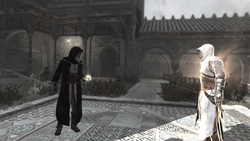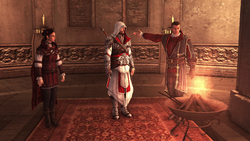
|
Patience, brothers. Soon we will reveal the secrets of Assassin's Creed III: Liberation, Assassin's Creed IV: Black Flag, Assassin's Creed Chronicles: India and Assassin's Creed: Initiates. This article has been identified as being out of date. Please update the article to reflect recent releases and then remove this template once done. |

|
We do this together or not at all. It has been proposed that this page be merged with Assassin leader, under the article: Mentor. Discussion to this effect can be held on the former article's talk page. |
| This article is about the highest rank of the Assassin Brotherhood, sometimes referred to as "Grand Master". You may be looking for other uses of the title. |
- "The Mentor's role is to oversee and coordinate the actions of the Order in the pursuit of harmony through free will."
- ―The Mentor, 2000.[src]

The emblem of the Assassin Order
The title of Mentor was an honorific title given to leaders of the Assassin Order who had obtained an extraordinary amount of skill and wisdom, and subsequently used these skills to tutor aspiring apprentices.[1]
The Assassin leaders who were assigned to direct the branches of the Brotherhood spread around the globe were granted the title of Mentor, once they had trained a specific number of apprentices and attained a high amount of skill and wisdom themselves.[1]
In 2000, the title of Mentor had become official and singular, with only a single Mentor leading the entire Assassin Order.[1] Typically, the Mentor acted as a living conduit for all of their predecessors, possessing the sum total of all of their knowledge and experience, which was passed down from Mentor to Mentor.[2] However, following this Mentor's death, the Great Purge was enacted, with the leadership of the Assassin Order under a specified Mentor waylaid in efforts to evade detection by the Templars.
History
Ptolemaic Egypt
In 47 BCE, the Medjay Bayek of Siwa founded the Hidden Ones, the first incarnation of the Assassin Brotherhood, in Egypt with his wife Aya. In 38 BCE, Bayek declared to the Hidden Ones that Aya, newly-christened as Amunet, was Mentor to Hidden Ones, thus marking the first time this title was used.[3]
Viking Age
During the 10th century, Torgny the Lawspeaker, the advisor of the King Eric of Sweden, was the Mentor of the proto-Assassins in Scandinavia. With his student Thorvald Hjaltason, he fought the proto-Templars Styrbjörn the Strong and Harald Bluetooth who invaded Sweden.[4]
Levantine Brotherhood

Al Mualim attempting to sway Altaïr to his cause
When the Hidden Ones reorganized themselves as the Assassin Brotherhood with a state in Western Asia, the title came to designate the head of the branch established by Rashid ad-din Sinan in Masyaf.[5][6] Sinan would from then on be known to the Levantine Assassins only by this title, which in Arabic was "Al Mualim".[7] When Al Mualim used his Apple of Eden to seize mental control of the Assassins in Masyaf, he was confronted and slain by his pupil Altaïr Ibn-La'Ahad, at which point the title passed to Altaïr.[8][9]
Such was the influence of the Levantine Assassins that to this day, when referring to Middle Eastern Mentors in other languages, such as English and French, the Arabic "Al Mualim" has been used in the capacity of a loanword.[10][11] Nevertheless, in these non-Arabic languages, the title remains most commonly associated with Sinan, even being treated as a name synonymous with him.[10]
With Altaïr's succession as Mentor, he enacted many reforms and innovations to the Assassin Brotherhood.[12] These changes along with his efforts to spread the influences of the Assassins made him the most legendary and respected Mentor of the entire order.[9]
In 1227, Altaïr's childhood rival Abbas Sofian staged a coup d'état against Altaïr, resulting in the Levantine branch falling under Abbas' leadership and Altaïr's self-imposed exile.[13] Usurping the title of Mentor,[9] Abbas tyrannically ruled the branch and its headquarters of Masyaf with a disregard for the Creed until he was finally killed by Altaïr in 1247,[13] marking the return of Altaïr's tenure as Mentor. Altaïr held this title for ten more years, until he disbanded the Levantine Assassins from Masyaf and passed away in his library during the Mongol attack on Masyaf on 12 August 1257.[14][15]
China
By 1259, Kang was the Mentor of the Chinese Brotherhood of Assassins during the twilight years of the Song dynasty. He recruited an officer of the Song army who died at the Siege of Diaoyu Castle. Kang initially took the officer's orphaned daughter Zhang Zhi under his wing but ultimately expelled her after she assassinated Möngke Khan without his permission.[16]
At the dawn of the 15th century, the scholar and politician Fang Xiaoru led the Chinese Brotherhood before the Yongle Emperor, a Templar ally, launched a purge against the Assassins in 1402.[17]
A century later, the Neo-Confucian philosopher Wang Yangming held the title of Mentor in China. As the core group of Chinese Templars, the Eight Tigers, led another Assassin purge during the Great Rites Controversy in 1524, Wang Yangming hid from them and Zhu Jiuyuan became the new Mentor.[18] With his apprentice Shao Jun, they fled to China to seek help from the retired Mentor Ezio Auditore da Firenze in Italy. When they arrived in Venice, Zhu Jiuyan was killed by the emperor's assassins.[19]
After her training with Ezio, Shao Jun returned to China in 1526 and contacted Wang Yangming, then still acting as the branch's Mentor. By this point, they were the last two remaining Chinese Assassins, and they embarked on a mission to assassinate the Eight Tigers. Wang Yangming was killed by their leader Zhang Yong in 1529, but Shao killed Zhang Yong in 1532 and revived the Brotherhood, becoming the new Mentor.[18]
Renaissance
- "You will now be known as il Mentore, the guardian of our Order and our secrets."
- ―Niccolò Machiavelli to Ezio Auditore.[src]
At the end of the 15th century, the Ottoman Grand Vizier Ishak Pasha became the Mentor of the Ottoman Brotherhood of Assassins. Until his death in 1497, he tried to establish a peace between the Ottoman Empire and the Assassins Brotherhood.[20] Later, his apprentice Yusuf Tazim took his role as the leader of the guild without pretending to the title of Mentor.[9]
By 1491, the Spanish Brotherhood of Assassins was led by the Mentor Benedicto. In 1492, he was captured by the Spanish Inquisition led by the Spanish Templar Tomás de Torquemada. Branded as a heretic, he was burned at the stake in Seville before the King Ferdinand II of Aragon and Queen Isabella I of Castile. [21] Years later, Aguilar de Nerha, who escaped from the pyre, became the new Mentor of the Spanish Brotherhood.[20]

Ezio Auditore being promoted to Mentor
During the late 15th century, the Italian Brotherhood of Assassins was led by Mario Auditore from Monteriggioni until his death in 1500 during the Siege of Monteriggioni by the hand of the Templar Cesare Borgia. Niccolò Machiavelli became the de facto leader of the Brotherhood. Mario's nephew, Ezio Auditore da Firenze, decided to build a new guild in Rome and recruit many citizens to fight the power of the Borgia. In August 1503, for his actions, Ezio was promoted to the rank of Mentor by Machiavelli.[22] He held this position for several years, and also acted as a leader and teacher to the Ottoman Assassins during his time in Constantinople while his sister Claudia led the Assassins in Italy.[9]
Ezio resigned as Mentor upon returning to Italy from the Ottoman Empire in 1513, and assigned Lodovico Ariosto to become his successor.[23] As of 1511, a descendant of Altaïr Ibn-La'Ahad, Iskender, held the position of Mentor of the Egyptian Assassins. Around this time, Iskender received aid from Ezio Auditore da Firenze after having been arrested and imprisoned. The Levantine Mentor Mujir was also rescued by Ezio's recruits when he was arrested by the Mamluks in Jerusalem. [24]
Colonial America
By 1673, the Mayan Bahlam was the Mentor of the West Indies Brotherhood of Assassins in Tulum. He tried to find the Sage to protect the Observatory from the West Indies Rite of the Templar Order. By 1713, his son Ah Tabai took his mantle as Mentor and continued his work. As he was betrayed by the schemes of the Assassin turncoat Duncan Walpole, Ah Tabai decided to move the headquarters of the Assassin. The Assassin and former pirate Edward Kenway gave his hideout in Great Inagua to make amend to unwillingly participate to Walpole treason.[25]
In 1732, the Assassin and former slave François Mackandal founded his own Brotherhood on the island of Saint-Domingue. He liberated slaves to recruit them in his Brotherhood. While he collected different Pieces of Eden, he also planed to poison all the white colonists of the island. In 1758, the Templars captured and burned him at the stake under the order of Madeleine de L'Isle, leading to the collapsing of the Brotherhood.[26]
One of Mackandal apprentice, Agaté fled to New Orleans after the death of his Mentor and he became the Mentor of the Louisiana Brotherhood of Assassins. He recruited Aveline de Grandpré, the daughter of his former lover Jeanne. Aveline operated as an Assassin on the field while Agaté stayed hidden in the Bayou. As their relationship became difficult, Agaté tried to kill Aveline believing she became a Templar. The Mentor committed suicide after his apprentice decided to spare his life.[26]
In 1776, Eseosa, grandson of the legendary Assassin and slave liberator Adéwalé, rebuilt the Brotherhood of Saint-Domingue and became his leader. Seeing Mackandal's actions as a disgrace, Eseosa decided to not follow his example and respect the first tenet of the Creed to not kill innocents. He led the Haitian Revolution with his brothers Assassins as Dutty Boukman, Georges Biassou and Toussaint Louverture. At the end of the Revolution, Eseosa remained one of the last Assassins, as some were killed, captured or betrayed the Brotherhood.[27]
In 1740, Ah Tabai sent the Assassin Achilles Davenport in the British colonies to found a new Brotherhood. There, he met John de la Tour an Assassin from Canada who searched Isu Temples. Working together, they arrived in Louisbourg in 1745 during the Siege of Louisbourg. John gave the title of Mentor to Achilles before sacrificing himself to give enough time to the Assassin to leave the city.[28]
During the mid 18th century, Achilles recruited many apprentices in the Colonial Brotherhood, constructed a powerful fleet and collected the Precursor box and Voynich manuscript. In 1755, one of his apprentice Shay Cormac inadvertently triggered an earthquake in Lisbon while exploring a Isu Temple. As Achilles refused to believe it was the Temple who activated the earthquake, Shay stole the manuscript. Branded as a traitor, Shay was left for dead before he joined the Colonial Templars. Shay tracked his former brothers but spared the life of Achilles that the Grand Master Haytham Kenway wanted dead. Haytham shot Achilles in the leg to impeach him to return on the field.[29]

Achilles and Connor in Boston
In 1763, most of the Assassins in Colonial America had been wiped out, leaving as only survivor Achilles. During the time before the American Revolutionary War, he was hesitant with training new Assassins, due to his agreement with the Templars concerning his life. Eventually, though, he trained Haytham's son Ratonhnhaké:ton as a member of the Brotherhood, leading him until his death.[30]
Under Achilles' reign, the Brotherhood regrew in the area, and the fight led by Ratonhnhaké:ton greatly diminished the influence of the Templar Order in the colonies. Following Achilles' death, Ratonhnhaké:ton assassinated the remaining Templar conspirators, presumably becoming the de facto Mentor.[30]
France
During the Middle Ages, the Mentor of the French Brotherhood was Guillaume de Nogaret, who most notably influenced King Philip IV of France into declaring the Templar Order illegal and assigned Master Assassin Thomas de Carneillon to lead the assault on the Templar headquarters. The raid was successful, with the Knights Templar disbanded and their Grand Master Jacques de Molay executed. Carneillon himself took the title of Mentor sometime after de Molay's execution.[31]
During the Hundred Years' War, the Queen Yolande of Aragon, mother-in-law of Charles VII of France, became the Mentor of the French Brotherhood. She prevented the Templars controlling England to take back France after the purge of the Templars a century before. She also financed the army of Jeanne d'Arc, recruiting her and training her to become an Assassin.[32]
At the end of the 17th century, another Mentor led the French Brotherhood. He tasked Louis-Joseph d'Albert de Luynes to recruit Julie d'Aubigny in the Brotherhood but this attempt failed. At the beginning of the 18th century, Mireille was the leader of the French Brotherhood. She became the lover of the highwayman Louis-Dominique Cartouche. She saved him from his public execution and introduced in the Brotherhood.[31]
During the French Revolution, the title was held by Honoré Gabriel Riqueti, comte de Mirabeau, a noted and venerated public speaker and one of the most famous contributors to the French Revolution. He was at the head of the French Assassin Council with four Master Assassins: Pierre Bellec, Guillaume Beylier, Hervé Quemar, Sophie Trenet His reign as Mentor saw two ultimately unsuccessful attempts to secure peace between the French Brotherhood and the Templars, the second of which resulted in Mirabeau's fatal poisoning by Pierre Bellec, who opposed any such truce. Bellec was later killed by his former apprentice Arno Dorian, leaving only three members in the Council. Though the leadership of the Brotherhood fell to Master Assassin Sophie Trenet, it would appear she did not take the title of Mentor as she was never addressed as such.[31]
Indian Broterhood
During the mid-19th century, the Mentor of the Indian Brotherhood of Assassins was Hamid. Under the leadership of Hamid, the Assassins were a strong presence in the Sikh Empire. Hamid instructed Assassin Arbaaz Mir to find a Piece of Eden known as the Koh-i-Noor. Located in the palace of Maharaja Ranjit Singh, the Piece of Eden was said to hold an immense amount of power and was sought heavily by the Assassins as well as the Templars.[33]
Modern time

Daniel Cross killing the Mentor
During the 20th century, the entire Assassin Order was united under a single Mentor.[1] By 1998, an individual known only as "the Mentor" led the Order, though his name and location were always kept secret – even from the Assassins themselves – for safety concerns, and he always stayed mobile to avoid being located. In November 2000, the Mentor invited Daniel Cross into his secret Dubai headquarters after having monitored his actions for two years, believing him to be a worthy apprentice.[2]
However, Daniel, whose brain had been unknowingly experimented upon by Abstergo Industries and imprinted with an impulse to kill the Mentor, subsequently assassinated him after having been rewarded with a Hidden Blade. Following this, the Assassins were thrown into disarray and forced underground,[2] and the mantle of leader was eventually picked up by William Miles.[9]
Known Mentors
References
- ↑ 1.0 1.1 1.2 1.3 Assassin's Creed Encyclopedia
- ↑ 2.0 2.1 2.2 2.3 Assassin's Creed: The Fall – Issue #3
- ↑ Assassin's Creed: Origins
- ↑ Assassin's Creed: Last Descendants – Fate of the Gods
- ↑ Assassin's Creed: Official Game Guide
- ↑ Assassin's Creed: Infographics
- ↑ Assassin's Creed
- ↑ Assassin's Creed – Paradise: Assassination
- ↑ 9.00 9.01 9.02 9.03 9.04 9.05 9.06 9.07 9.08 9.09 9.10 Assassin's Creed: Revelations
- ↑ 10.0 10.1 Assassin's Creed: Rogue – "Berg's Inspiration"
- ↑ Assassin's Creed: Unity – A Crown of Thorns
- ↑ Assassin's Creed II
- ↑ 13.0 13.1 Assassin's Creed: The Secret Crusade
- ↑ Assassin's Creed: Revelations – Passing the Torch
- ↑ Assassin's Creed: Revelations – Lost Legacy
- ↑ 16.0 16.1 Assassin's Creed: Last Descendants – Tomb of the Khan
- ↑ Assassin's Creed: Revelations – Discover Your Legacy
- ↑ 18.0 18.1 18.2 18.3 18.4 Assassin's Creed Chronicles: China
- ↑ Assassin's Creed: Embers
- ↑ 20.0 20.1 Assassin's Creed: Rebellion
- ↑ Assassin's Creed (film)
- ↑ 22.0 22.1 Assassin's Creed: Brotherhood
- ↑ 23.0 23.1 Assassin's Creed: Revelations novel
- ↑ Assassin's Creed: Revelations – Mediterranean Defense
- ↑ Assassin's Creed IV: Black Flag
- ↑ 26.0 26.1 Assassin's Creed III: Liberation
- ↑ Eseosa's Codex
- ↑ Assassin's Creed: Rogue – War Letters
- ↑ Assassin's Creed: Rogue
- ↑ 30.0 30.1 30.2 Assassin's Creed III
- ↑ 31.0 31.1 31.2 31.3 31.4 31.5 31.6 31.7 Assassin's Creed: Unity
- ↑ Assassin's Creed: Heresy
- ↑ 33.0 33.1 Assassin's Creed: Brahman
- ↑ 34.0 34.1 Assassin's Creed: Origins – The Hidden Ones
- ↑ Assassin's Creed: Last Descendants – Fate of the Gods
- ↑ Assassin's Creed: Memories
- ↑ Assassin's Creed: Heresy
- ↑ 38.0 38.1 Assassin's Creed: Rebellion
- ↑ Assassin's Creed (film)
- ↑ Assassin's Creed: Memories
- ↑ 41.0 41.1 41.2 Assassin's Creed: Initiates – Surveillance
- ↑ Assassin's Creed IV: Black Flag
- ↑ Assassin's Creed: The Official Movie Novelization
- ↑ 44.0 44.1 Assassin's Creed III: Liberation
- ↑ Assassin's Creed: Last Descendants
- ↑ Assassin's Creed: The Fall – Issue #1
- ↑ Assassin's Creed: Syndicate – Database: Galina Voronina
- ↑ Assassin's Creed: Syndicate - Database: Shaun Hastings

![Hidden One Bayek.png (2.74 MB) Bayek[34] Egyptian Brotherhood (c. 47 BCE – ?)](https://static.wikia.nocookie.net/assassinscreed/images/c/c1/Hidden_One_Bayek.png/revision/latest/scale-to-width-down/122?cb=20240405122718)
![ACO Aya render.png (469 KB) Aya[34] Roman Brotherhood (c. 47 BCE – ?)](https://static.wikia.nocookie.net/assassinscreed/images/c/cf/ACO_Aya_render.png/revision/latest/scale-to-width-down/104?cb=20171027012840)
![Wiki noimage.jpg (30 KB) Torgny[35] Viking Brotherhood (c. 984)](https://static.wikia.nocookie.net/assassinscreed/images/6/69/Wiki_noimage.jpg/revision/latest/scale-to-width-down/180?cb=20140622155635)
![ACR Altair Render2.png (1.29 MB) Altaïr Ibn-La'Ahad[9] Levantine Brotherhood (1191 – 1227; 1247 – 1257)](https://static.wikia.nocookie.net/assassinscreed/images/9/93/ACR_Altair_Render2.png/revision/latest/scale-to-width-down/75?cb=20130502201908)
![AC Malik render.png (3.65 MB) Malik Al-Sayf[9] Levantine Brotherhood (1217 – 1228)](https://static.wikia.nocookie.net/assassinscreed/images/c/c6/AC_Malik_render.png/revision/latest/scale-to-width-down/60?cb=20140331174121)
![Abbas Sofian render.png (54 KB) Abbas Sofian[9] Levantine Brotherhood (1227 – 1247)](https://static.wikia.nocookie.net/assassinscreed/images/8/80/Abbas_Sofian_render.png/revision/latest/scale-to-width-down/93?cb=20130102142047)
![ACU De Carneillon Render.png (364 KB) Thomas de Carneillon[31] French Brotherhood (c. 1307 – ?)](https://static.wikia.nocookie.net/assassinscreed/images/5/5f/ACU_De_Carneillon_Render.png/revision/latest/scale-to-width-down/64?cb=20150120161254)
![ACM Benedicto 3.jpg (44 KB) Benedicto[39] Spanish Brotherhood (? – 1492)](https://static.wikia.nocookie.net/assassinscreed/images/0/0a/ACM_Benedicto_3.jpg/revision/latest/scale-to-width-down/133?cb=20170430182611)
![AC Aguilar Cropped.jpg (2.54 MB) Aguilar de Nerha[38] Spanish Brotherhood (?)](https://static.wikia.nocookie.net/assassinscreed/images/5/50/AC_Aguilar_Cropped.jpg/revision/latest/scale-to-width-down/123?cb=20160512051259)
![ACB Machiavelli render.png (3.75 MB) Niccolò Machiavelli[40] Italian Brotherhood (c. 1503)](https://static.wikia.nocookie.net/assassinscreed/images/8/8d/ACB_Machiavelli_render.png/revision/latest/scale-to-width-down/102?cb=20130408100644)
![ACI-Ezio.png (264 KB) Ezio Auditore da Firenze[22] Italian Brotherhood (1503 – 1513)](https://static.wikia.nocookie.net/assassinscreed/images/6/66/ACI-Ezio.png/revision/latest/scale-to-width-down/87?cb=20131014134656)
![ACCC Wang Yangming.png (441 KB) Wang Yangming[18] Chinese Brotherhood (? – 1524; c. 1526 – 1529)](https://static.wikia.nocookie.net/assassinscreed/images/7/7e/ACCC_Wang_Yangming.png/revision/latest/scale-to-width-down/114?cb=20150415051314)
![ACCC Zhu Jiuyuan.jpg (41 KB) Zhu Jiuyuan[18] Chinese Brotherhood (1524)](https://static.wikia.nocookie.net/assassinscreed/images/3/39/ACCC_Zhu_Jiuyuan.jpg/revision/latest/scale-to-width-down/180?cb=20150426130415)
![ACCC-Shao Jun Render.png (896 KB) Shao Jun[18] Chinese Brotherhood (c. 1532 – ?)](https://static.wikia.nocookie.net/assassinscreed/images/0/0e/ACCC-Shao_Jun_Render.png/revision/latest/scale-to-width-down/103?cb=20150407215640)
![AC4 Ah Tabai render.png (494 KB) Ah Tabai[42] West Indies Brotherhood (1713 – c. 1745)](https://static.wikia.nocookie.net/assassinscreed/images/c/c5/AC4_Ah_Tabai_render.png/revision/latest/scale-to-width-down/68?cb=20140916204815)
![ACRG Achilles render.png (1.66 MB) Achilles Davenport[30] Colonial Brotherhood (1746 – 1763)](https://static.wikia.nocookie.net/assassinscreed/images/6/6b/ACRG_Achilles_render.png/revision/latest/scale-to-width-down/69?cb=20141129043048)
![AgateDatabaseHD.png (350 KB) Agaté[44] Louisiana Brotherhood (1759 – 1777)](https://static.wikia.nocookie.net/assassinscreed/images/f/f6/AgateDatabaseHD.png/revision/latest/scale-to-width-down/90?cb=20140118171834)
![ACU Mirabeau Render.png (403 KB) Honoré Gabriel Riqueti, comte de Mirabeau[31] Parisian Brotherhood (? – 1791)](https://static.wikia.nocookie.net/assassinscreed/images/5/5c/ACU_Mirabeau_Render.png/revision/latest/scale-to-width-down/71?cb=20150120161037)
![ACCI Hamid.png (982 KB) Hamid[33] Indian Brotherhood (c. 1839 – ?)](https://static.wikia.nocookie.net/assassinscreed/images/5/5b/ACCI_Hamid.png/revision/latest/scale-to-width-down/81?cb=20160115132745)
![MentorTheFall.png (347 KB) The Mentor[2] Worldwide (? – 2000)](https://static.wikia.nocookie.net/assassinscreed/images/3/36/MentorTheFall.png/revision/latest/scale-to-width-down/90?cb=20111231183555)
![GOG TheOsakaBrotherhood M.jpg (345 KB) Saeko Mochizuki[41] Japanese Brotherhood (2013 – present)](https://static.wikia.nocookie.net/assassinscreed/images/8/8c/GOG_TheOsakaBrotherhood_M.jpg/revision/latest/scale-to-width-down/155?cb=20131218024717)
![ACi-Matricide.jpg (267 KB) Medeya Voronina[47] Russian Brotherhood (? – 2014)](https://static.wikia.nocookie.net/assassinscreed/images/2/2d/ACi-Matricide.jpg/revision/latest/scale-to-width-down/180?cb=20141218142202)
![AC3 William Miles.png (4.63 MB) William Miles[48] Worldwide (c. 2015 – present)](https://static.wikia.nocookie.net/assassinscreed/images/4/45/AC3_William_Miles.png/revision/latest/scale-to-width-down/64?cb=20140311201937)

